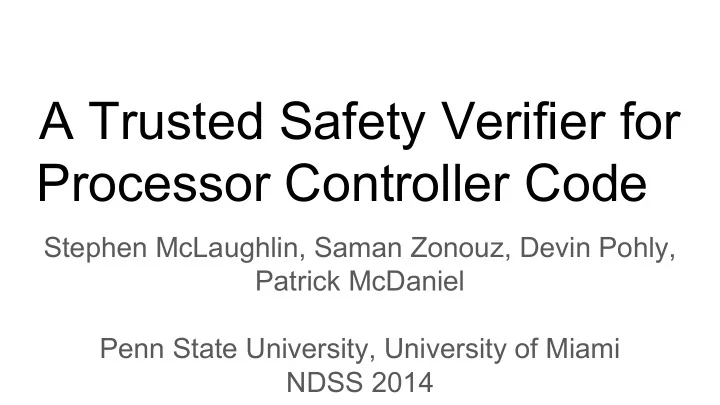

A Trusted Safety Verifier for Processor Controller Code Stephen McLaughlin, Saman Zonouz, Devin Pohly, Patrick McDaniel Penn State University, University of Miami NDSS 2014
Industrial Control Systems 101 ● Control systems are everywhere ○ Power grid, automation, manufacturing, transportation, etc. ○ Big implications if hacked ● Control systems are attractive for attackers ○ Stuxnet ○ Port scanning PLCs ○ Remote network attacks on PLCs
Trusted Computing Base ● “Set of all subsystems that are required for security of a system” ○ Hardware ○ Firmware ○ Network ○ Software ○ You name it! ● Problem: ICS TCB is TOO BIG! ● Solution: Build a system to reduce the size
Programmable Logic Controller (PLC) ● “Digital, multi-input multi-output computer used for automation of physical machinery” ● Reads sensor measurements, takes action on those measurements ● Has a fixed program that runs continuously as long as the PLC is on ○ Each execution called a scan cycle ○ Input memory, program execution, output memory ● TSV Goal: Efficiently check code coming over the interface for safety properties
Threat Model
Limitations ● Underlying assumption is that the firmware on PLC is trusted ○ Firmware attacks can bypass PLC ● Bad sensor data is out of scope ● Inside attacker is out of scope
IL(IL) ● PLC programs are written in “Instruction List”, which is a form of ladder logic ○ Looks like a graphical diagram based on logic hardware ○ Set of instructions to operate physical machinery ● IL programs are vendor specific , so they are very hard to analyze directly ● Authors built ILIL, which is a set of “top-level instructions followed by function definitions” ○ Elevated IL to a program with no side effects , so safety properties can be measured
Symbolic Execution ● Analyze a program to see what inputs produce what outputs ○ Naively think of trying all possible inputs and outputs to every branch in a program ● TSV creates symbolic scan cycle ○ Set of logic formulas that should map all inputs and outputs ○ SMT solver used to prune infeasible branches ○ Hard deadline termination reduces the symbol equation space ○ Lump all inputs that produce similar outputs to reduce solving space ● Why is this useful?
Checking Temporal Properties ● PLCs are always running, so multiple runs of the same program touch pre-modified memory values ○ Symbolic execution is not enough, we need temporal model checking ○ Use Linear Temporal Logic (LTL) to define safety rules
Temporal Execution Graph ● High level: State machine that models the symbols from step 1 and the safety properties from step 2 ● Inputs: symbolic scan cycle, LTL predicates, termination deadline ● Steps ○ Initialize the TEG with 0 values for all PLC variables/predicates/symbols ○ Load scan cycle and predicates ○ For each predicate, evaluate if it is satisfiable from previous state ○ If so, create a new state, and determine whether or not it already exists in the graph ■ If it exists, don’t add it ■ If it doesn’t, create a state transition ● Malicious code discovery: Show to the operator an example of why the system failed the check
Performance
Discussion
Recommend
More recommend